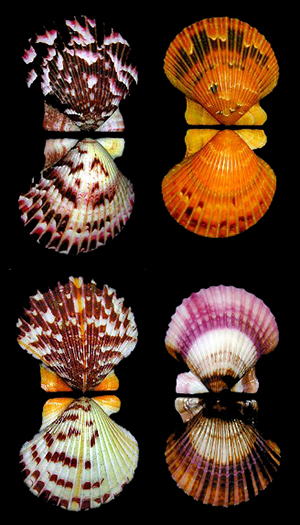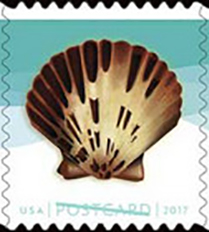Argopecten ventricosus G. B. Sowerby II, 1842

(Da: www.jaxshells.org)
Phylum: Mollusca Cuvier, 1797
Classe: Bivalvia Linnaeus, 1758
Ordine: Pectinida Adams & Adams, 1857
Famiglia: Pectinidae Rafinesque, 1815
Genere: Argopecten Monterosato, 1889
Sinonimi
= Argopecten ventricosus ssp. aequisulcatus Carpenter, 1864 = Pecten (Aequipecten) aequisulcatus Carpenter, 1864 = Pecten aequisulcatus Carpenter, 1864 = Pecten calli Hertlein, 1925 = Pecten compactus Dall, 1898 = Pecten fililextus C. C. Li, 1930 = Pecten inca d'Orbigny, 1846 (sinonimo) = Pecten newsomi Arnold, 1903 = Pecten pomatea Valenciennes, 1846 (sinonimo) = Pecten solidulus Reeve, 1853 (sinonimo) = Pecten subventricosus Dall, 1898 = Pecten tumidus G. B. Sowerby I, 1835 (non valido: omonimia di Pecten tumidus Turton, 1822) = Pecten ventricosus G. B. Sowerby II, 1842 (basionimo) = Pecten ventricosus ssp. aequisulcatus Carpenter, 1864 (sinonimo).
Bibliografia
–Kinoshita T (1935) A test for natural spat collection of the Japanese scallop. Report of the Hokkaido Fish Research Station, 273:1-8.
–Shumway SE & Parsons GJ (2006). Scallops: Biology, Ecology and Aquaculture. Elsevier B.V., Amsterdam.
–Cervigon, Fernando (Editor), 1983: La acuicultura en Venezuela. Caracas. 123p.
–Dabinett PE (1989). Hatchery production and grow-out of the giant scallop Placopecten magellanicus. Bulletin of the Aquaculture Association of Canada, 89(3):68-70.
–Neima PG (1997). Report on commercial scallop hatchery design. Canadian Technical Report of Fisheries and Aquatic Sciences, No. 2176. 55 pp.
–Ryan CM (2000). Effect of algal cell density, dietary composition, growth stage and macronutrient concentration on growth and survival of giant scallop Placopecten magellanicus (Gmelin, 1791) larvae and spat in a commercial hatchery. MSc Thesis. Memorial University, Newfoundland.
–Hardy D (1991). Scallop Farming. (ed. D Hardy) Fishing News Books, Blackwell Science, Oxford.
–Loew, Chris (Mar 13, 2019). "CEI releases market analysis of ear-hung scallops farmed in Maine". Seafood source. Retrieved March 13, 2019.
–Lucas A (1982). La nutrition des larves de bivalves. Oceanis 8(5):363-388.
–Coutteau P & Sorgeloos P (1992). The use of algal substitutes and the requirement for live algae in the hatchery and nursery rearing of bivalve molluscs: an international survey. Journal of Shellfish Research, 11:467-476.
–Robert R & Trintigna P (1997). Substitutes for live microalgae in mariculture: a review. Aquatic Living Resources, 10:315-327.
–Farías A & Uriarte I (2001). Effect of microalgae protein on the gonad development and physiological parameters of Chilean scallop Argopecten purpuratus (Lamark, 1819). Journal of Shellfish Research, 20:97-105.
–Uriarte I (2000). Informe de Avance No.3, FONDECYT 1970807, Chile. 11p.
–Ball MC & McGladdery SE (2001). Scallop parasites, pests and diseases: implications for aquaculture development in Canada. Bulletin of the Aquaculture Association of Canada, 101(3):13-18.
–"An Overview of China's Aquaculture", p. 6. Netherlands Business Support Office (Dalian), 2010. Accessed 13 Aug 2014.
–Ren W, Chen H, Renault T, Cai Y, Bai C, Wang C, Huang J (2013) Complete genome sequence of acute viral necrosis virus associated with massive mortality outbreaks in the Chinese scallop, Chlamys farreri" Virol J 10(1) 110.
–Shumway SE, Sherman-Caswell S & Hurst WJ (1988). Paralytic shellfish poisoning in Maine: monitoring a monster. Journal of Shellfish Research, 7: 643-652.
–Yautomo T, Murata M, Oshima Y, Matsumoto GK & Clardy J (1984). Diarrehetic shellfish poisoning. In: Seafood Toxins (ed. EP Ragelis). American Chemical Society, Washington D.C. pp. 207-214.
–Tovar A, Moreno C, Mánuel-Vez MP & García-Vargas M (2000). Environmental impacts of intensive aquaculture in marine waters. Water Research, 34(1): 334-342.
–Shumway SE, Davis C, Downey R, Karney R, Kraeuter J, Parsons J, Rheault R & Wikfors G (2003). Shellfish aquaculture - In praise of sustainable economies and environments. World Aquaculture, 34(4):15-17.

|
Data: 28/01/2017
Emissione: Conchiglie marine Stato: U.S.A. Nota: Emesso in una striscia di 4 v. diversi Autoadesivo |
|---|